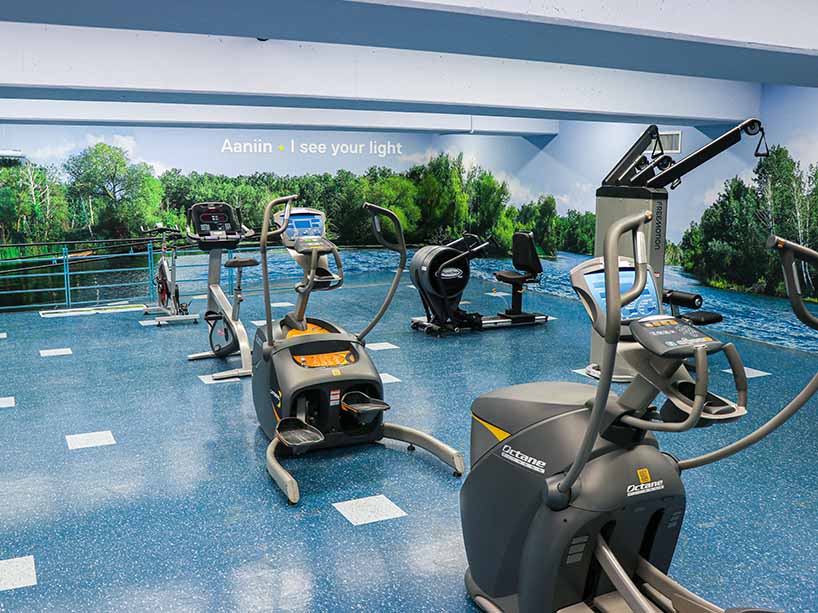The RAC reopens with new immersive space dedicated to local Indigenous history

The new First Nations Immersive Space in the RAC will help community members harness the benefits of being surrounded by nature, like elevated mood and academic benefits. Photo credit: Mark Samy.
Those returning to the Recreation and Athletics Centre (RAC) this fall may notice a valuable addition to the cardio and strength circuit room in the building. Over the summer, Ryerson’s Athletics and Recreation department worked with Indigenous colleagues and the university’s Indigenous Space Sub-Working Group (ISSWG) to find a space where local Indigenous history and wellbeing practices would be recognized.
The result is a new First Nations Immersive Space that welcomes visitors with an Ojibwe greeting: “Aaniin,” and, “I see your light” in English. Upon entering the activity space, you are met with floor to ceiling imagery of nature. The concept of bringing trees, plants, wildlife and water into the RAC was a collaboration between Athletics and Recreation and the ISSWG. It was executed by Emmy-award-winning Anishinaabe artist Caroline Brown, who comes from Teme-Augama Anishinabai (People of the Deep Water), Whitebear family, Loon clan and Temagami First Nation. The vision is a nod to Taddle Creek, the waterway that ran beneath the current location of the RAC and flowed into Lake Ontario until the early 1860s. Photography for the project was taken this summer near the Toronto Islands by Ryerson alumna, Natalia Dolan (image arts, ‘08).
“We created a feeling that lifts the ceiling, expands the horizons and places you in calm waters,” said Brown. “Even down to the clear baseboards, the sky, clouds, islands and water scene is uninterrupted.”
Bringing history to life
Ryerson alumna Natalia Dolan and Anishinaabe artist Caroline Brown photographed the nature at the Toronto Islands to tie back to Taddle Creek, which ran through campus in the 1800s. Video credit: Mark Samy
Educating the community about Taddle Creek and the local Indigenous history is an integral part of the First Nations Immersive Space. Professor and Indigenous advisor in the Ted Rogers School of Management, Michael Mihalicz, also a member of the ISSWG, has conducted research on Taddle Creek as part of his published work called, (PDF file) St. James Square & The Lost Rivers. According to Mihalicz’s research, Taddle Creek had been a place for various Indigenous Nations to gather and fish. The trail that ran through the current site of the RAC would have been used by the Mississaugas and others.
“We looked at the history of the land to know what would have been here,” said Andrew Petit, director of Recreation, Equity and Active Well-Being in the department of Athletics and Recreation. “Michael's research was pivotal to painting a picture of what would have been.”
Brown adds that it’s important to tie back to the land and how the land is part of Indigenous knowledge and teachings. “It’s important to know the First People, who honour the land, and to know that anywhere you are - even in concrete buildings - that you can honour the land,” she said. “When you connect to the land, It gives something back to you.”
The First Nations Immersive Space will have a plaque and a QR Code where people can engage with the imagery and learn more about the history of Taddle Creek.
Connecting to nature
Pettit also points to the health and academic benefits of connecting to nature.
“Indigenous peoples have known for a long time that there is a connection to nature and well-being,” he said. “Our minds and bodies change when we are connected to nature.”
The physical benefits to being surrounded by nature include elevated mood, elevated heart rate, blood pressure changes and a shift in brain activity. There are also positive academic impacts like increased problem solving and critical thinking.
Dolan, who remembers the RAC from when she was a student at Ryerson, is happy to see a space where students can positively adjust to returning to campus. “Coming back to a space focused on prioritizing their wellbeing and an emphasis on our connection to nature will make a big difference,” she said.
Find out more about the RAC reopening.





